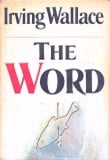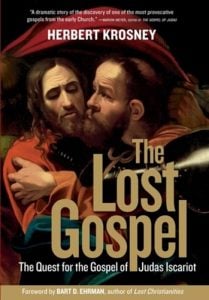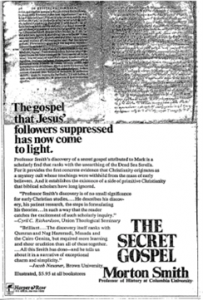In this third and final post on his new book Gospel Thrillers, Andrew Jacobs moves into where the rubber meets my (our) road: how these novels really do seem like real life when you think about Bible scholarship and the real discoveries (or discoveries *claimed* to have been made, by bona fide scholars) of new Gospels that threaten to undo everything we think about Jesus and / or the New Testament. Intriguing stuff. What do you think?
You can get Andrew’s just now published book anywhere good books are sold, including here: Gospel Thrillers: Conspiracy, Fiction, and the Vulnerable Bible: Jacobs, Andrew S.: 9781009384612: Amazon.com: Books
******************************
III. Gospel Thrillers come to Life
In my first blogpost I described the quirky genre of novels I call Gospel Thrillers and the way they illuminate cultural fears and desires about the Bible; I then described some of their “bombshell” secrets which, at the end most novels, turn out to be duds: readers of conspiratorial fictions more often want status quo restored than to see our familiar world blown apart.
Yet as I show throughout Gospel Thrillers, these stories about biblical conspiracy are not confined to the pages of fiction. These novels capture and magnify popular fears and desires about the vulnerability of the Bible to misinterpretation, mistranslation, and mischief. Every so often these narratives about the political, theological, and personal dangers to the Bible break out into real-world controversies that sounds an awful lot like the narratives of the thrillers that began appearing in the 1960s.
I begin Gospel Thrillers by comparing the newly found “Gospel of James” from the 1972 novel The Word with the real-world publication and promotion in 2012 of a Coptic fragment called “the Gospel of Jesus’ Wife.” The “Gospel of James” revealed unknown teachings from Jesus about universal education, economic equality, and spiritual liberation from “superstition and dogma.” The Gospel of Jesus’ Wife, while just a fragment, suggested (to some) the possibility of a church open to and welcoming of expressions of human sexuality.

Both fictional and nonfictional gospel inspired readers to reimagine the progressive possibilities of Christian origins; both gospels also struck some skeptics as “too good to be true,” playing into the modern, progressive desires of a public weary of patriarchal, institutional religion.
Both gospels also turned out to be forgeries. In The Word, an unscrupulous and hardened French ex-convict forged the blockbuster Gospel of James in order to (somehow) to get vengeance against the Roman Catholic church that betrayed him. The Gospel of Jesus’s Wife was concocted by a German émigré with less clear motives but certainly with his own animus against the Roman Catholic church.
The Gospel of Jesus’s Wife made front-page headlines: first when it was unveiled to the public and next when it was debunked as a forgery not long after. The course of its rise and fall reads like the plot of a Gospel Thriller, as desire for a biblical bombshell quickly turned into suspicion about the political, theological, and personal motives behind it: not just those of the forger but of the academics who promoted it. At the end, status quo prevailed.
The Gospel of Jesus’ Wife was not the first time the Gospel Thrillers narrative played out in real life, on the front page of newspapers and in vituperative academic clashes. In 2007 a team sponsored by National Geographic published a previously unknown Gospel of Judas, a Coptic, gnostic text that had been painstakingly reconstructed out of papyrus sheets supposedly languishing for twenty years in a US safe deposit box.

The official story of the Gospel of Judas read, once more, like the pages of a Gospel Thriller: global intrigue, shadowy forces, uncertain motives, the possibility of a shocking new twist on Christian origins. After publication, the controversy shifted to interpretation of the Gospel of Judas, playing out in the popular press as a heated debate between scholars accusing each other of manipulating the text’s meaning for their own ends. Once more, the vulnerability of the Bible became starkly visible on the public stage.
That the same kinds of controversies surrounded both the Gospel of Jesus’s Wife and the Gospel of Judas show that it’s not just a question of forgery or authenticity that drives the anxieties about biblical vulnerability: a “real” text from the past stirs up the same fears and desires as a forged fragment. Indeed, the inability to tell the difference between what is authentically biblical and what is not lies at the heart of our fears and anxieties about the vulnerable Bible.
One debate over forgery and the vulnerability of the Bible has haunted academic circles for more than sixty years, resurfacing every decade or so in a new article, book, or newspaper story. In 1960 Columbia University classicist Morton Smith announced to an academic audience a fragment of a “secret” Gospel of Mark embedded in a second-century letter copied in the early modern period into the flyleaves of a printed book. He had come across the book, letter, and “secret” gospel while cataloguing the library of the Mar Saba Monastery outside Jerusalem.
Smith’s “Secret Gospel of Mark” generated controversy right away, not least from Smith’s suggestion that this early gospel bore witness to arcane private rituals or spiritual (and possibly physical) union conducted by Jesus alone with male disciples. In 1973, Smith published two books on Secret Mark: a highly specialized study of the Greek text and its possible ritual contexts and a popular account of his find with a more public-facing explanation of his new theories about Christian origins.

Controversy about the Secret Gospel and Smith’s theories continued throughout his life; after his death in 1991, fellow scholars began floating suggestions—or even downright accusations—that Smith had forged these gospel fragments as a hoax on the academy [see Bart’s recent discussion here]. Debate has continued to this day, with new theories and motives adduced ranging from the political to the theological to the deeply personal. Multiple books have been written, the most recent just last year.
The endless fascination with Morton Smith and the Secret Gospel of Mark illustrates, I think, the ongoing appeal of Gospel Thrillers as a fictional genre. Even readers with only the slimmest attachment to “the Bible” are compelled by its totemic presence in US culture coupled with its persistent vulnerability to new discoveries and theories (real, forged, or unknown). While some “real world” controversies flame out and fade away, others—like Secret Mark—come back again and again, reviving fears and hopes around biblical vulnerabilities.
The novels, on the other hand, act as both a release valve and a containment chamber. They magnify the stakes of biblical vulnerability to fantastical proportions: global conspiracies, spectacular assassination, secrets that (we are told) men and women would die, or kill, to protect. Like all thrillers, they give readers the chance to vicariously experience the thrill and threat of life-changing secrets revealed… and then they end. The covers of the book close and the threat, and the thrill, are once more contained. As I say at the close of Gospel Thrillers: “Perhaps as long as the Bible remains both totemic and vulnerable, Gospel Thrillers will keep appearing to assuage US readers’ anxiety and contain their biblical fears and desires.”
Gospel Thrillers is available at a discount in e-book format now (Amazon and Barnes & Noble) and will be available in the United States in hardback in February (Cambridge Press site; Amazon). For more about the novels and their context, check out my companion website with summaries, reviews, and more information about the Bible and conspiracy. For more information about me, visit my academic website.


A great set of posts. Thanks. I’m old enough to remember The Word as a TV miniseries, which aired in the late 1970s, starring David (The Fugitive) Janssen. It struck me at the time as being quite daring and unusual venturing as it did into what can still be pretty sensitive territory. Church attendance and religious belief was more widespread then. Certainly, such thrillers would not be possible, even now, with regard to certain other major religions, without the authors having to be put into protective custody for the rest of their lives.
Yes, The Word is probably the most successful of all the novels I look at (Kate Mulgrew was in that mini-series, too!).